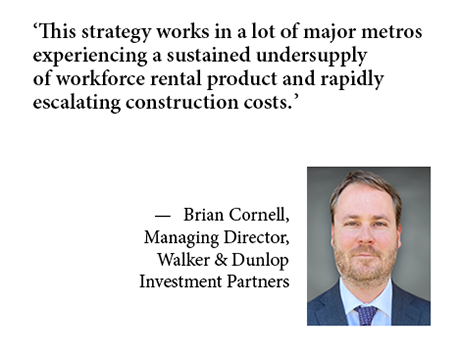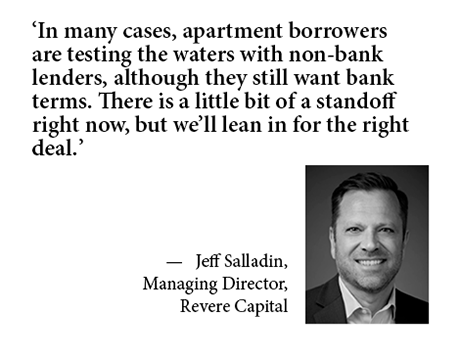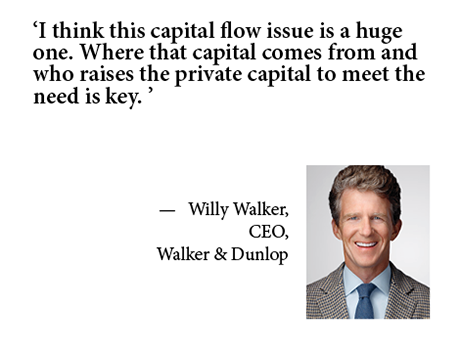Technology, like commercial real estate, becomes increasingly vulnerable to the need for replacement and updates over time. Just as multifamily landlords can update properties by periodically replacing outmoded flooring and fixtures to suit the latest occupier preferences, technology must also keep up with the latest trends. For the best renter experience, multifamily properties need Internet connectivity that will serve residents as their technological needs grow and their tolerance for frequent outages diminishes. Disruptions associated with repairs or network upgrades can threaten customer satisfaction and renewal rates. Unfortunately for many landlords who rely on traditional telecommunications lines for their properties’ Internet, modern usage is straining older infrastructure. Booming wireless technology use is gobbling up bandwidth to connect everything from consumers’ phones and laptops to fitness monitors, smart TVs and other household appliances. As a vice president of product catalog who has worked for over a decade at broadband service provider Pavlov Media, John Danner understands the problem of limited Internet bandwidth all too well. He is eager to see technological improvements that will replace these old systems. “The old copper infrastructure can’t meet the requirements of the next generation of wireless connectivity,” explains Danner. “With fiber-optic connections, the sky is the …
Content Partner
Affordable HousingContent PartnerFeaturesHospitalityMidwestMultifamilyNortheastSoutheastTexasWalker & DunlopWestern
Underutilized Hotel Properties Present Conversion Opportunities for Multifamily, Affordable Housing
Walker & Dunlop is finding financial success while helping to provide high-demand, affordable housing in key markets by converting hotel assets into multifamily buildings. Brian Cornell, managing director at Walker & Dunlop Investment Partners (WDIP), says his firm is identifying hotels that are already built out and can accommodate market-rate multifamily use. Extended-stay hotels have the best layout for this type of conversion because their footprint already includes the floor plans and many of the amenities that multifamily residents expect. “The units are typically one-bedroom, but with some two-bedroom suites and studios,” he outlines. “This creates a variety of unit types within the existing physical build-out of the property, and these assets can operate as true multifamily without having to combine walls and do extensive capital renovations.” When it comes to location, Cornell explains, “We prefer infill locations that have strong employment drivers and a dearth of affordable housing.” Underutilized Properties, Multifamily Strategies The three investments Walker & Dunlop has done in the past two years are in the heart of commercial corridors, in areas where there are limited multifamily projects within a two-to-three-mile radius offering rents that can support an 80 percent area median income (AMI) threshold. One is …
Retailers, developers and leasing agents who attended the ICSC LAS VEGAS 2023 conference in May left the show cautiously upbeat about the state of retail. It was only the second consecutive gathering since the pandemic shut down the annual show in 2020 and 2021, and many brands made known their intent to remain in expansion mode, especially fast-casual restaurants, car washes, coffee shops, auto parts stores, entertainment concepts and medical services. The only obstacle stopping them at this point is the higher rental rates that they may have to pay as a consequence of higher construction costs, says George Macoubray, vice president of retail brokerage for NAI Elliott in Portland, Oregon. “A lot of these concepts are doing well,” declares Macoubray, whose Northwest Retail Advisors team represents landlords and regional and national tenants throughout Oregon and Washington. “We’ll see how far these tenants can go in terms of what they pay to fill new projects, but the enthusiasm and willingness to grow is definitely there.” Practicing Vigilance The same can’t be said for ICSC conference attendees who are on the capital markets side of the business. Higher interest rates have fueled a bid-ask spread between buyers and lenders, while regulatory …
For real estate investors who have an acquisition teed up or who need to refinance, the prospects of finding debt today are arguably the bleakest they have been since the financial crisis 15 years ago. Higher interest rates and concerns over growing distress convinced banks and other lenders to move to the sidelines several months ago, thwarting commercial real estate investment sales. In turn, that is fueling broad uncertainty over what properties are really worth, which only begets more unease among banks. But private debt funds, which typically provide short-term rate bridge loans, are more likely to make deals when banks will not, says Jeff Salladin, a managing director with Dallas-based debt fund Revere Capital. That’s because debt funds like Revere raise capital from sophisticated investors to fund their loans, he says, while banks rely on deposits. That subjects banks to stringent regulatory oversight, which is especially intense in today’s debt climate. “All investors dislike uncertainty, and banks are investors by another definition,” states Salladin, who oversees real estate lending for Revere. “As a result, we could be in the first inning of a golden era for debt funds like ourselves, because we’re more flexible in way banks can’t be.” …
A rapidly evolving connectivity frontier is shaping the future of cell tower lease sales and encouraging many commercial property owners who rent space to tower companies to sell their leases at values at the top of the market. Telecom carriers have considerably slowed their buildouts for 5G networks and are already preparing for 6G mobile networks, expected to roll out around 2024. Brokers are seeking to amend and renegotiate old cell tower leases in the face of predicted wireless infrastructure obsolescence and connectivity innovations, which may negate some physical infrastructure needs entirely. The key to maximizing sale proceeds in this landscape is to secure landlord-friendly terms and ensure clarity in a new lease or renewal. Among other elements, building owners must insist on strong insurance indemnities and well-defined subordination, non-disturbance and attornment (SDNA) in the amended agreements. But no landlord demand may be more important to future value than denying the tenant a right of first refusal to purchase the lease, says David Moore, CEO and principal of NAI Global Wireless, a Redlands, California-based national wireless real estate brokerage that represents landlords. Cell tower leases in which tenants don’t have right of first refusal are more appealing to buyers, a …
BohlerContent PartnerDevelopmentFeaturesLife SciencesMidwestMultifamilyNortheastSoutheastTexasWestern
Part 2: How to Promote Collaboration, Efficiency in Life Sciences Innovation Districts Via Design
In the biotech and pharmaceutical sectors, life sciences innovation districts have become hubs not only for research and development but also for cooperation and inspiration between cohorts. These districts, often called innovation districts, collect together companies, research institutions, supporting entities, housing and more. Innovation districts necessitate meticulous planning and design strategies to promote scientific inquiry and efficiency. “Municipalities, schools, corporations and organizations that have close ties to their state are piloting life sciences innovation district development, allowing them to group otherwise separated uses — work, recreation, living areas and more — together. When you pair these institutions and include innovative site and building programming in a single location, you move beyond disconnected projects and amenities to a united innovation district that can magnify benefits across organizations,” explains Dan Danvers, a landscape architect project manager with Bohler, a land development consulting and site design company. This article is the design-focused component of our two-part series on life sciences innovation districts. If you would like to read about the planning component of these complex developments, please read our first article here. Moving Life Sciences Innovation Districts Forward Innovation districts must keep pace with evolving technologies and research. Life sciences industries are continually progressing, …
By Willy Walker, CEO of Walker & Dunlop I recently had the pleasure of sitting down to talk with some prominent members of the Walker & Dunlop team, including Kris Mikkelsen, executive vice president of investment sales, Aaron Appel, senior managing director of capital markets, and Ivy Zelman, executive vice president of research and securities. In this episode of the Walker Webcast, “State of CRE,” we covered some of the most prominent issues the commercial real estate industry is facing, as well as some headwinds it will continue to face in the future. Changes in Homebuilding and Consumer Spending Although homebuilders had to offer incentives when rates first started increasing last year, they are still seeing a steady demand for homes, as demand still heavily outpaces supply. This imbalance is seen in the new and existing home market. Single-family homes in many markets across the country are in multiple offer situations, indicating that single-family residential real estate is still strong. This is incredible, given the fact that many existing homeowners are locked into mortgage rates in the 2-5 percent range, giving them little reason to move out of their current home. How Mortgage Deals Are Currently Financed Although we are …
Life sciences-anchored innovation districts are becoming increasingly popular as hubs for research and development in the biotech and pharmaceutical industries. These districts, also known as “innovation districts,” are characterized by clusters of companies, research institutions, supporting organizations, living areas, amenities and offices all located in close proximity. This grouping requires detailed planning and design strategies to maximize their potential for scientific exploration and success on an enormous, ambitious scale. Master planning and engaging site civil engineering partners early on in the process can save time and money once a project reaches the design stage. This article is the first installment in a two-part series on life sciences innovation districts to discuss, first, the planning, and, then, the design elements required by these districts. Read about design in Part 2, here. Fostering innovation, collaboration and productivity is at the heart of planning for life sciences innovation districts. The successes of famous examples such as North Carolina’s Research Triangle Park, Kendall Square in Cambridge, Mass. and Mission Bay in San Francisco indicate how beneficial a melting-pot mix of residential, commercial and research spaces can be when they concentrate talent from research institutions, life sciences innovators, universities and the surrounding community. “Many life …
Content PartnerDevelopmentFeaturesIndustrialLeasing ActivityLee & AssociatesMidwestMultifamilyNortheastOfficeRetailSoutheastTexasWestern
Lee & Associates’ First-Quarter 2023 Sector-by-Sector Analysis Indicates Market-Wide Cooling
High interest rates and economic uncertainty in the first quarter of this year contributed to lower absorption and declining rent growth in industrial, retail and multifamily sectors across the country, with some regional exceptions, according to Lee & Associates’ 2023 Q1 North America Market Report. Meanwhile office continues to struggle. The sector experienced its third-largest quarterly contraction since the beginning of the pandemic, as work-from-home preferences decoupled office occupancy from job growth numbers. The full Lee & Associates report is available (with further breakdowns of factors like vacancy rates, market rents, inventory square footage and cap rates by city) here. The analysis below provides an overview of four major commercial real estate sectors alongside trends, economic background and exceptions within each sector. Industrial Overview: Sharp Decline Hits First-Quarter U.S. Demand There was a sharp first-quarter decline in U.S. tenant demand for industrial space as wholesalers and retailers reconsider their inventory levels out of caution over the economic outlook. Net absorption in the first quarter totaled 39.4 million square feet, a 57 percent drop from the record set a year ago. The overall U.S. vacancy rate settled at 4.4 percent, an increase of 40 basis points from the close of 2022, comfortably …
On the April 12 episode of “The Most Insightful Hour in CRE” webcast, Willy Walker, CEO of Walker & Dunlop, spoke to renowned economist Dr. Peter Linneman, founding principal of Linneman Associates, about pressing issues facing the economy, pandemic repercussions, market predictions and much more. The discussion began by diving into the economy and real estate market in its current state of flux, with many challenges facing both investors and developers. Walker outlines the unease created by the recent Silicon Valley Bank and Signature Bank crises. “One of the data points announced by the Fed is that since the crisis, bank lending in the United States has gone down by $110 billion over the two weeks since the Silicon Valley Bank collapse. Banks borrowed $160 billion in the two-week window prior. There’s a big drive toward liquidity; and yet there’s no new liquidity going out into the market.” “There’s 4.4 trillion dollars of commercial real estate (CRE) loans outstanding across all lending sources — CMBS, life insurance companies, banks, etc.,” continues Walker. “About half of that is non-multifamily properties. Banks hold about 40 percent of total outstanding loans on commercial properties.” If banks were to pull back from holding 40 percent …











